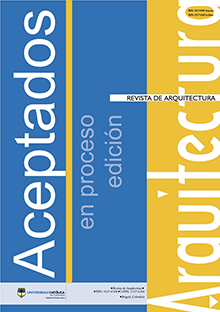
Esta obra está bajo una licencia internacional Creative Commons Atribución-NoComercial 4.0.
La Revista de Arquitectura se cataloga como una publicación de acceso abierto. Más información >>>
Los autores conservarán los derechos de autor y garantizarán a la Revista de Arquitectura el derecho de primera publicación de la obra, el cual estará simultáneamente sujeto a la licencia Creative Commons (CC) BY-NC.
Los autores suscribirán una licencia no exclusiva de distribución de la versión de la obra publicada mediante la firma de (RevArq FP03 Autorización reproducción)
El Autoarchivo estará de acuerdo con los criterios expresados por SHERPA/RoMEO y la clasificación Verde.
Para ver en detalle estos lineamientos, por favor consultar >>>
Resumen
La pared Trombe (PT) es una estrategia arquitectónica pasiva que utiliza la radiación solar para mejorar el rendimiento térmico de los edificios. Sin embargo, la mayoría de los estudios sobre esta solución se han centrado en climas templados. Este trabajo tiene como objetivo analizar el impacto de la presencia y las dimensiones de los respiraderos en la capa interna de una PT sobre el rendimiento térmico de un ambiente, considerando períodos fríos y cálidos en dos zonas bioclimáticas brasileñas de clima templado: Juiz de Fora (ZB3) y Brasilia (ZB4). La metodología se basó en simulaciones computacionales realizadas con el software DesignBuilder, comparando diferentes configuraciones de la PT con un modelo de referencia sin pared, en los periodos de invierno y verano. Los resultados indicaron que la PT sin respiraderos elevó la temperatura del aire interior en ambos climas, con un menor impacto en verano. Por otro lado, la presencia de aberturas intensificó el calentamiento, con variaciones de hasta 2,6 °C en Juiz de Fora y 2,9 °C en Brasilia, debido a la acción convectiva. Sin embargo, los cambios en las dimensiones de los respiraderos no tuvieron una influencia significativa, lo que indica que la existencia de las aberturas es más determinante que su tamaño.
Palabras clave

Citas
Alharbi, K. A. M., Aldosari, O., Sina, N., Aybar, H. Ş., Fuxi, S., Alkhatib, S. E., & Mousa, A. A. A. (2022). Installation of rectangular enclosures filled with phase change nanomaterials on the thrombus walls of a residential building to manage solar radiation in different seasons of the year. Journal of Building Engineering, 57, 104732. https://doi.org/10.1016/j.jobe.2022.104732
Associação Brasileira de Normas Técnicas. (2005). Desempenho térmico de edificações – Parte 3: Zoneamento bioclimático brasileiro e diretrizes construtivas para habitações unifamiliares de interesse social (NBR 15220-3).
ASHRAE. (2017). Thermal environmental conditions for human occupancy (ASHRAE/ANSI Standard 55, Issue. ASHRAE. https://www.ashrae.org/technical-resources/bookstore/standard-55-thermal-environmental-conditions-for-human-occupancy
Bevilacqua, P., Benevento, F., Bruno, R., & Arcuri, N. (2019). Are Trombe walls suitable passive systems for the reduction of the yearly building energy requirements? Energy, 185, 554-566. https://doi.org/10.1016/j.energy.2019.07.003
Cavalcanti, F. S., & Caram, R. M. (2016). Avaliação do uso de fachada solar no litoral do nordeste brasileiro: o caso das paredes trombe. Revista Brasileira de Energia Solar, IV, 6. https://doi.org/10.59627/rbens.2013v4i1.93
Charqui, Z., El Moutaouakil, L., Boukendil, M., Hidki, R., Zrikem, Z., & Abdelbaki, A. (2023). Numerical simulation of turbulent coupled heat transfer in a Trombe wall subjected to periodic thermal excitations. Energy and Buildings, 278, 112631. https://doi.org/10.1016/j.enbuild.2022.112631
Chen, T., Liu, S., Wang, Y., Shen, Y., Ji, W., Xu, Z.,…Mazhar, A. R. (2025). An optimization method coupling the response surface methodology and multi-objective particle swarm to enhance the performance of a novel water Trombe wall. Applied Thermal Engineering, 267, 125785.https://doi.org/10.1016/j.applthermaleng.2025.125785
Facelli Sanchez, P., & Mercado Hancco, L. (2024). Trombe walls with porous medium insertion and their influence on thermal comfort in flats in Cusco, Peru. Energy and Built Environment, 5(2), 194-210.https://doi.org/10.1016/j.enbenv.2022.09.003
Fernandes, J. E. P., Mateus, R., & Bragança, L. (2012). Princípios de sustentabilidade na arquitectura vernacular em Portugal, Congresso Construção 2012, Coimbra, Portugal. https://repositorium.sdum.uminho.pt/bitstream/1822/22290/1/CC2012_Fernandes_Mateus_Braganca.pdf
Givoni, B. (1998). Climate considerations in building and urban design. John Wiley & Sons.
Guo, S. R., Jiang, X. C., Jia, Y. H., Xiang, M. L., Liao, Y. X., Zhang, W. T., ... & Long, E. S. (2023). Experimental and numerical study on indoor thermal environment of solar Trombe walls with different air-channel thicknesses in plateau. International Journal of Thermal Sciences, 193, 108469. https://doi.org/10.1016/j.ijthermalsci.2023.108469
Hami, K., Draoui, B., & Hami, O. (2012). The thermal performances of a solar wall. Energy, 39(1), 11-16. https://doi.org/10.1016/j.energy.2011.10.017
Hong, X., Leung, M. K. H., & He, W. (2019). Thermal behaviour of Trombe wall with venetian blind in summer and transition seasons. Energy Procedia, 158, 1059-1064. https://doi.org/10.1016/j.egypro.2019.01.257
Instituto Nacional de Meteorologia, I. (2016). Dados históricos. https://portal.inmet.gov.br/dadoshistoricos
Irshad, K., Algarni, S., Islam, N., Rehman, S., Zahir, M. H., Pasha, A. A., & Pillai, S. N. (2022). Parametric analysis and optimization of a novel photovoltaic trombe wall system with venetian blinds: Experimental and computational study. Case Studies in Thermal Engineering, 34, 101958. https://doi.org/10.1016/j.csite.2022.101958
Islam, N., Irshad, K., Zahir, M. H., & Islam, S. (2021). Numerical and experimental study on the performance of a Photovoltaic Trombe wall system with Venetian blinds. Energy, 218, 119542. https://doi.org/10.1016/j.energy.2020.119542
Jing, H., Chen, Z., & Li, A. (2015). Experimental study of the prediction of the ventilation flow rate through solar chimney with large gap-to-height ratios. Building and Environment, 89, 150-159. https://doi.org/10.1016/j.buildenv.2015.02.018
Krüger, E., Suzuki, E., & Matoski, A. (2013). Evaluation of a Trombe wall system in a subtropical location. Energy and Buildings, 66, 364-372. https://doi.org/10.1016/j.enbuild.2013.07.035
Lin, Y., Ji, J., Zhou, F., Ma, Y., Luo, K., & Lu, X. (2019). Experimental and numerical study on the performance of a built-middle PV Trombe wall system. Energy and Buildings, 200, 47-57. https://doi.org/10.1016/j.enbuild.2019.07.042
Luccas, A. V., & Matoski, A. (2023). Estudo da viabilidade da aplicação da parede “trombe” na região de Curitiba XVI Sicite, Ponta Grossa, Paraná.
Mabrouki, A., Bennani Karim, Y., Ouadghiri Hassani, H., Jamali, Y., & Khaldoun, A. (2023). A study of a passive heating design employing a Trombe wall with PCM: A numerical investigation of the semi-oceanic climate in Morocco. Materials Today: Proceedings, 72, 3626-3631. https://doi.org/10.1016/j.matpr.2022.08.410
Monghasemi, N., & Vadiee, A. (2018). A review of solar chimney integrated systems for space heating and cooling application. Renewable and Sustainable Energy Reviews, 81, 2714-2730. https://doi.org/10.1016/j.rser.2017.06.078
Monteiro, L. M. (2016). Parede Trombe: estudo experimental comparativo de desempenho térmico para aquecimento e arrefecimento na cidade de São Paulo Universidade de São Paulo. São Paulo.
Rabani, M., Kalantar, V., & Rabani, M. (2019). Passive cooling performance of a test room equipped with normal and new designed Trombe walls: A numerical approach. Sustainable Energy Technologies and Assessments, 33, 69-82. https://doi.org/10.1016/j.seta.2019.03.005
Saadatian, O., Sopian, K., Lim, C. H., Asim, N., & Sulaiman, M. Y. (2012). Trombe walls: A review of opportunities and challenges in research and development. Renewable and Sustainable Energy Reviews, 16(8), 6340-6351. https://doi.org/10.1016/j.rser.2012.06.032
Sergei, K., Shen, C., & Jiang, Y. (2020). A review of the current work potential of a trombe wall. Renewable and Sustainable Energy Reviews, 130, 109947. https://doi.org/10.1016/j.rser.2020.109947
Sheikholeslami, M., & Al-Hussein, H. R. A. (2023). Modification of heat storage system involving Trombe wall in existence of paraffin enhanced with nanoparticles. Journal of Energy Storage, 58, 106419. https://doi.org/10.1016/j.est.2022.106419
Simões, N., Manaia, M., & Simões, I. (2021). Energy performance of solar and Trombe walls in Mediterranean climates. Energy, 234, 121197. https://doi.org/10.1016/j.energy.2021.121197
Wang, D., Hu, L., Du, H., Liu, Y., Huang, J., Xu, Y., & Liu, J. (2020). Classification, experimental assessment, modeling methods and evaluation metrics of Trombe walls. Renewable and Sustainable Energy Reviews, 124, 109772 https://doi.org/10.1016/j.rser.2020.109772
Wu, S.-Y., Wu, L.-F., & Xiao, L. (2023). Effects of aspect ratio and inlet wind velocity on thermal characteristics of Trombe wall channel under different ventilation strategies: An indoor experiment. Experimental Thermal and Fluid Science, 141, 110800. https://doi.org/10.1016/j.expthermflusci.2022.110800
Zhou, S., & Razaqpur, A. G. (2024). CFD modeling and experimental validation of the thermal performance of a novel dynamic PCM Trombe wall: Comparison with the companion static wall with and without PCM. Applied Energy, 353, 121985. https://doi.org/10.1016/j.apenergy.2023.121985
Ziebell, C., & Aymone, J. L. (2020). Seleção de concepção de paredes PT. Design em pesquisa, 3, 546–563. https://lume.ufrgs.br/handle/10183/212664

































